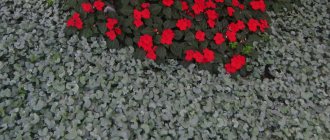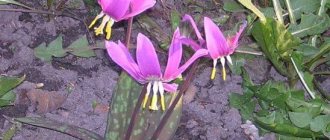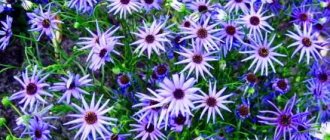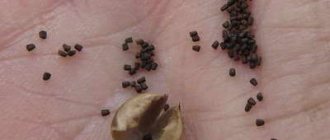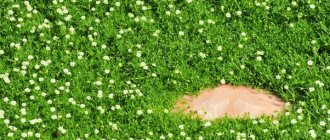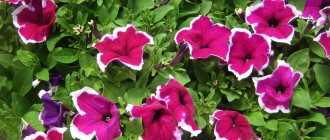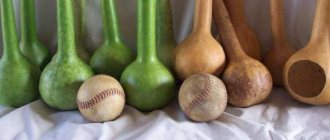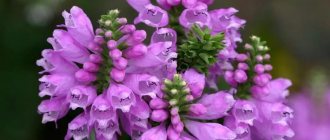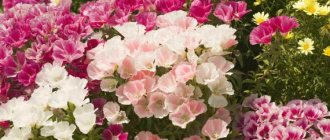The festive and cheerful appearance of the not-so-modest annual Ursinia invariably brings a smile. Undemanding, low-maintenance, but impressive and catchy, this beauty can become the star of a fashion summer collection. Golden baskets and bright greenery of expanding, but easily controlled bushes, and the modest requirements of Ursinia can only compete with its endurance. This beauty blooms right up to frost, tirelessly releasing new inflorescences and decorating garden ensembles in the second half of the season.
Ursinia dill 'Solar Fire'. © entireleaves
The golden cheerfulness of wedge antennae
Flower growers lovingly call Ursinia “wedge antennae,” and in its homeland it is known under the famous name “treasure of the fields.” But whatever you call this annual plant, one thing is certain: this is one of the most elegant annual plants with basket-like inflorescences. Ursinia captivates with her optimism, amazingly colorful and catchy appearance. Even its leaves are festive, and there’s no need to talk about the inflorescences that just beg to be included in bouquets.
Ursinia is a genus of plants of the Asteraceae family, numbering about 60 species of herbaceous plants and subshrubs, growing wild mainly on the African continent.
Ursinias are herbaceous annuals, perennials and subshrubs with fragrant bare or pubescent stems, on which alternately pinnately dissected or pinnately incised leaves with a beautiful serrated edge are located. The color of the greenery is bright, rich, and always seems fresh, as if the plant has just been refilled.
Ursinia inflorescences are classic baskets. They bloom singly or in bunches of inflorescences, each flower is clearly visible. Orange or yellow ligulate flowers with a rounded edge and a dark brown-red reverse side and dark, fragrant, small tubular flowers in the center create amazingly beautiful “daisies”. The center of the inflorescences, although not large, seems surprisingly catchy thanks to the contrast. After flowering, ribbed, tufted achenes are formed.
Biological description of Ursinia
The genus Ursinia includes annual and perennial herbs, less often subshrubs. The height of the plant reaches 30-60 cm. The narrow leaves are dark green, pinnate, dissected or serrated, fragrant, and resemble carrot foliage in appearance. There are varieties with pubescent leaves. The usual arrangement of leaves is alternate. All above-ground parts of the plant have pinpoint glands, resulting in a strong aroma when rubbed.
The flowers resemble yellow, orange daisies; when opened, they reach 5-6 cm. In the botanical sense, this is not exactly a flower, it is an inflorescence consisting of flowers of different structures. The reed forms are located along the edge, and the tubular forms are located in the center of the inflorescence. The marginal flowers are single-row, sterile. Their color is bright, shiny, monochromatic, at the base of the bend they often have a darker shade, and from below the surface of the tongues is copper-colored. The disc flowers are numerous, small, bisexual, and purple at the tip of the corolla. The scaly receptacle is flat or convex. The predominant colors of flowers are yellow and orange, white and purple shades are less common. Blooms for a long time, from mid-summer to the end of September.
Types and varieties of Ursinia
Ursinia, despite the fact that there are perennial species in the genus, is cultivated as an annual plant in ornamental gardening, even in regions with mild winters. Lush and long flowering exhausts the plants so much that it is impossible to achieve success from it in subsequent years. Ursinias are grown not only as garden crops, but also as indoor plants. And no matter what form they grow in and no matter how they are used, wedge antennae still remain bright and attractive.
In gardening they actively use:
- dill ursinia (ursinia anethoides) - an annual plant up to 40 cm high, forming a lush, densely bushy crown, above which orange baskets of inflorescences with a diameter of up to 5 cm bloom in a continuous cushion. The leaves are narrowly dissected, seem airy-light (the only type of ursinia in which flowers above the greenery bloom even on cloudy and rainy days). Dill ursinia has a wonderful dwarf variety “Aurora” - an annual plant up to 30 cm high with orange baskets of inflorescences decorated with cherry spots at the base of the reed flowers.
- beautiful ursinia (ursinia speciosa) from 30 to 40 cm in height with smaller but graceful baskets of inflorescences up to 4 cm in diameter; the inflorescences of this beauty bloom only in good weather, but flowering starts earlier - in mid-June (in addition to the basic form with a golden-orange color, there is the Albida variety with a white center of the baskets and late flowering, starting in July);
- dwarf ursinia (ursinia pygmaea) up to 15 cm high with numerous orange inflorescences, very beautiful carved foliage (it stands out not for the size of the inflorescences, but for their number);
- multi-flowered ursinia (ursinia anthemoides subsp. versicolor), forming tall, half-meter bushes with golden five-centimeter baskets of inflorescences sitting on thin slender peduncles; the baskets look charming with a dark spot at the base of the ray flowers, echoing the brown center of the tubular flowers.
Ursinia anthemoides subsp. versicolor.
© stobie Ursinia is used in garden design:
- in the design of flower beds from summer gardens;
- in mixed flower beds and mixborders;
- in borders and narrow ridges;
- to create catchy single accents on the lawn;
- as a cut plant;
- for decorating street flowerpots, stone flower bowls, balcony boxes;
- in potted gardens on balconies, terraces, and recreation areas.
Application in landscape design
The best place to design a site for Ursinia would be alpine hills and stone gardens. The plant also looks very impressive in hanging baskets. If daily watering is not possible (living off-site), this is one of the best choices for such a design. Of the varieties, the dwarf variety and dill undine are best suited for hanging flowerpots. Low-growing varieties look excellent in the design of garden paths and as borders for flower beds.
When planted together with other flower crops, the best partners for wedgeweeds will be cornflower, bluebells, lobelia, common chamomile, and Iberis. Dahlias will look great in the background. For single plantings, it is better to give preference to round and ribbon forms.
Conditions required by Ursinia
For Ursinia to become the star of the summer garden collection and bloom tirelessly from July until frost, it only needs to be provided with minimal conditions - a sunny location with fertile, high-quality soil. This summer plant does not tolerate shading, but it is not afraid of drafts and winds, because the bushes are dense and the shoots are strong. True, in cold, uncomfortable areas, ursinia will not bloom as profusely as in warm places.
As for the soil, drainage, light texture and nutritional value are the only parameters that are important for ursinia. It does not tolerate stagnant moisture and waterlogging, but the plant can be planted in any place provided the soil composition is improved and drainage is established (without improvement, plant growth on heavy, clayey, dense soil will be inhibited). For ursinia, you must dig the soil deeply.
Beautiful Ursinia (Ursinia speciosa). © Magnus Manske
Botanical description and homeland of the plant
No matter how much we admire roses and similar beauties, it is difficult to resist the tenderness and simplicity of flowers similar to daisies. Ursinia is an unpretentious summer plant for the garden (there are perennial species, but in the conditions of central Russia only seasonal cultivation is possible). The culture comes from South Africa. Gardeners have noticed elegant, eye-catching bushes for a long time and lovingly call the plant wedge-shaped. In America it is known as the “treasure of the fields” - the petals are yellow, orange-golden.
- Ursinia belongs to the Asteraceae family and its basket-shaped inflorescences.
- What are visually perceived as petals, from a botanical point of view, are reed flowers, and the core consists of numerous small tubular flowers; they have a delicate scent.
- The base of the reed flowers and the surface of the tubular flowers are of the same chocolate shade, followed by a uniform yellow or orange color.
- On the reverse, the “petals” are red-brown. The white-flowered form is extremely rare.
When does Ursinia bloom?
Ursinia is distinguished by its tireless, abundant flowering. The corollas bloom in July and are regularly renewed until the plant dies from autumn frosts.
Ursinia grows as a subshrub with a height of about 0.6 m. It branches, the stems and shoots are bare or covered with short fibers. Together with the leaves, they have a herbaceous-tart aroma. In structure, the leaf blades resemble carrots: dissected, with beautiful jagged edges, green in color of varying saturation, matte or shiny, as if they had just been poured with water.
Most reviews about growing ursia are positive. Gardeners admire the beauty of flowers that can outshine the beloved daisies and asters. The more saturated color of the core contrasts with the warm yellow-orange petals. Some note poor seed germination. Perhaps the reason lies in their poor quality. To grow successfully in a flower bed, plants need warmth and plenty of sun.
Features of caring for Ursinia
Ursinia is an undemanding flyer. It will bloom beautifully even without care, but if you want to achieve truly spectacular and abundant flowering, and most importantly, lasting for months, provide the plant with minimal care. First of all, during heat and drought, compensate for the weather with moderate, infrequent, at least minimal watering. The hotter it is, the more often you water the bushes - and Ursinia will survive even the most extreme summer.
Since the inflorescences of this crop are large and bloom in amazing quantities for 3 months or more, ursinia quickly depletes the soil. And the loss of nutrients must be compensated by applying full mineral fertilizers in a standard dosage at least once a month or once every 20 days.
Ursinia grows not in height, but in breadth; the clumps become more voluminous and lush. But the plant is very easy to control: if you want to keep the annual plant more compact and miniature, then simply cut off unnecessary shoots and “pacify” it from all sides.
Ursinia is quite cold-resistant and in the fall, at the first drop in night temperatures, it is by no means the first to finish flowering. It will show off in compositions until the first serious frost and will decorate the autumn garden with its cheerful curtains.
Preparing the site and planting seedlings in open ground
African ursinia develops and blooms best in an open, warm, sunny place. The strong stems can withstand even strong gusts of wind and stand straight. Shade is contraindicated for the plant. For lush flowering, the area must be well lit for at least 5 hours a day.
It is unpretentious in the choice of soil: moderate or even depleted soil is suitable. On soil rich in nutrients, shoots and leaves grow, but there are few flowers. Good drainage is important, so avoid heavy loamy substrates. Light sandy loam soil is ideal.
- Before planting, dig up the area, level the ground and make planting holes according to the size of the earthen ball.
- Handle the seedlings, leaving the root collar flush with the soil surface, and water.
- Leave a gap of 25 cm between ursinia bushes.
Pests and diseases of Ursinia
In general, Ursinia can be considered a fairly persistent flyer. When plantings are dense and waterlogged, neighbors affected by powdery mildew pose a danger to this plant. But among the pests, aphids most often settle on ursinia.
If problems arise, fighting is useless; it is better to wait until flowering is complete and throw away the plant than to spray the bushes with insecticides for a long time and unsuccessfully. It’s better to spend time preventing infection of neighboring crops.
Ursinia nudicaulis. © faroutflora
Diseases and pests
Ursinia is resistant to infections, but rots easily when the soil moisture is high. Excess moisture can also easily cause powdery mildew. First of all, you need to adjust the care and stop watering and fertilizing. Copper-containing preparations such as Oxychom, Hom and others are recommended for treatment.
Of the insects, aphids are the most annoying to the crop. In the initial stages of damage, you can try to fight it with the help of Biovit, Atelik, Alatar and other insecticides, however, reviews from experienced gardeners indicate that these measures are rarely effective. Unfortunately, the best solution would be to completely destroy the planting and burn the uprooted bushes to prevent the spread of aphids throughout the entire dacha area.
Growing Ursinia from Seeds
Like all annuals, ursinia can be propagated exclusively by seeds. At the same time, the persistent beauty prefers sowing in open ground.
Sowing directly into the soil is carried out at the end of April or the first ten days of May. It is better not to bury the seeds too deeply and scatter them quite rarely. After the appearance of the first true leaf, the seedlings are thinned out, leaving 1 plant for every 15-20 cm of soil.
Ursinia is propagated through seedlings only if they want to speed up flowering. Sowing should be done early, at the end of February or March. In this case, it is better to sow ursinia in large containers. They can germinate without covering with film or glass in any warm room. After sowing, the seeds should be covered not with soil, but with a layer of sterile sand (height - 2-3 cm).
As they grow and produce true leaves, young shoots should be picked into separate containers. Ursinia seedlings are planted in the soil, maintaining a distance of 20 to 30 cm between plants only after the threat of late frosts has disappeared.
Reproduction of Ursinia
Ursinia propagates by sowing small seeds in April in a greenhouse, or in May directly into open ground. The seeds should not be buried; they are simply scattered over the surface, covered with a layer of sand of about 3 cm. The result is equally good with any method. In order to achieve earlier flowering, the seeds are planted for seedlings in March. For the appearance of friendly shoots, when growing ursinia from seeds, create an optimal temperature of 15-20 C. Seedlings are planted once. Seedlings are planted in a permanent place on the site at the end of May, after the end of frost, maintaining a distance of 25-30 cm. Before transplanting, young plants are gradually hardened.
LiveJournal


